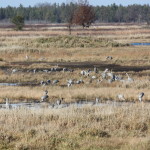 In his essay, “Marshland Elegy,” Aldo Leopold mourned the steady decline of sandhill cranes – and the wildness they represent – in the upper Midwest. All lost to a thing called progress.
In his essay, “Marshland Elegy,” Aldo Leopold mourned the steady decline of sandhill cranes – and the wildness they represent – in the upper Midwest. All lost to a thing called progress.
Seven decades later, the trumpeting voices of thousands upon thousands of cranes ring out across the marshes and river valleys of central Wisconsin each fall. Have we achieved a different kind of “progress,” or do the sandhill cranes deserve the credit for this happier state of affairs?
Perhaps both. Certainly some of the progress humans have made since Leopold wrote his essay has included protecting and even restoring places where native plants and animals can live. Meanwhile, sandhill cranes have learned to find a meal in some decidedly non-native places: corn fields, golf courses, farm yards. At night, though, when they need safety, there’s no substitute for a wetland or shallow river.
At Necedah National Wildlife Refuge yesterday, I stood on the observation platform and looked out on a wetland filled with cranes. Many cranes are here all summer, nesting and raising their young. But many more nested farther north, and are mustering here before departing in large southbound flocks.
They’ll fly toward Chicago and the southern tip of Lake Michigan (I’ve seen them high, high above the interstate in Lake County), then to Indiana, Kentucky, eastern Tennessee, and Georgia on their way to winter habitat in Florida.
I have come to think of the sandhill cranes in Wisconsin – even the ones that stop over on fall migration – as “our” cranes: they’re a defining part of our landscape. But they are not only ours. The decisions we make as stewards of Wisconsin’s waters affect the birds that other people, from Ontario to Florida, also watch and regard as “their” cranes.
As long as the numbers of sandhill cranes keep growing, it’s a sign that somewhere to the north and somewhere to the south, wetlands and rivers of which cranes approve can still be found, and it’s a sign that people in those places are not only watching cranes, but watching over their waters. That sounds like progress to me.
Try this: Where do “your” birds spend the winter? To see the migration routes and winter habitats on which your favorite birds depend, see the species descriptions at www.allaboutbirds.org. Range maps show migration routes and winter habitats not only within the U.S., but hemisphere-wide for long-distance migrants.
